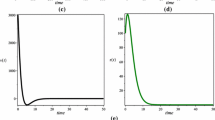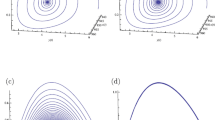Abstract
In this paper, the authors consider a four-compartmental HIV epidemiological model, which describes the interaction between HIV virus and two target cells, CD4 T cells and macrophages in vivo. It is proved that the bilinear incidence can cause the backward bifurcation, where a locally asymptotically stable disease-free equilibrium co-exists with a locally asymptotically stable endemic equilibrium when the basic reproduction number \((R_{0})\) is less than unity. It is shown that a sequence of Hopf bifurcations occur at the endemic equilibrium by choosing one parameter of the model as the bifurcation parameter. Meanwhile, the global asymptotic stabilities of the equilibria are established by constructing suitable Lyapunov functions under some conditions. Furthermore, the authors develop an extended model by incorporating with the intracellular delays and derive global asymptotic stability of the delayed model by constructing Lyapunov functions. Some numerical simulations for justifying the theoretical analysis results are also given.





Similar content being viewed by others
References
Adams BM, Banks HT et al (2005) HIV dynamics: modeling, data analysis, and optimal treatment protocols. J Comput Appl Math 184:10–49
Culshaw RV, Ruan S (2000) A delay-differential equation model of HIV infection of CD4+ T-cells. Math Biosci 165:27–39
Duffin RP, Tullis RH (2002) Mathematical models of the complete course of HIV infection and AIDS. J Theor Med 4:215–221
Elaiw AM (2010) Global properties of a class of HIV models. Nonlinear Anal Real World Appl 11:2253–2263
Feng Z, Castillo-Chavez C et al (2000) A model for tuberculosis with exogenous reinfection. Theor Popul Biol 57:235–247
Greenhalgh D (1997) Hopf bifurcation in epidemic models with a latent period and nonpermanent immunity. Math Comput Model 25:85–107
Hadeler KP, Driessche PV (1997) Backward bifurcation in epidemic control. Math Biosci 146:15–35
Hossein P, Sergei SP, Patrick DL (2014) Global analysis of within host virus models with cell-to-cell viral transmission. Discret Contin Dyn Syst Ser B 19:3341–3357
Hu Z, Liu X et al (2010) Analysis of the dynamics of a delayed HIV pathogenesis model. J Comput Appl Math 2:461–476
Huang G, Takeuchi Y, Ma W (2010) Lyapunov functionals for delay differential equations model of viral infection. SIAM J Appl Math 70:2693–2708
Kirschner D (1999) Dynamics of co-infection with M. tuberculosis and HIV-1. Theor Popul Biol 55:94–109
Korobeinikov A (2004) Global properties of basic virus dynamics models. Bull Math Biol 66:879–883
Leenheer PD, Smith HL (2003) Virus dynamics: a global analysis. SIAM J Appl Math 63:1313–1327
Li J, Yang Y, Zhou Y (2011) Global stability of an epidemic model with latent stage and vaccination. Nonlinear Anal Real World Appl 12:2163–2173
Liu W (1994) Criterion of Hopf bifurcations without using eigenvalues. J Math Anal Appl 182:250–256
Lu T, Huang Y et al (2014) A refined parameter estimating approach for HIV dynamic model. J Appl Stat 41:1645–1657
McCluskey CC (2010) Global stability fo ran SIR epidemic model with delay and nonlinear incidence. Nonlinear Anal Real World Appl 11:3106–3109
Ouattara DA (2005) Mathematical analysis of the HIV-1 infection: parameter estimation, therapies effectiveness, and therapeutical failures. In: 27th Annual international conference of the IEEE engineering in medicine and biology society, China, 9
Perelson AS, Essunger P et al (1997) Decay characteristics of HIV-1 infected compartments during combination therapy. Nature 387:188–191
Perelson AS, Nelson PW (1999) Mathematical analysis of HIV-1 dynamics in vivo. SIAM Rev 41:3–44
Qesmi R, Wu J et al (2010) Influence of backward bifurcation in a model of hepatitis B and C viruses. Math Biosci 224:118–125
Regoes RR, Wodarz D, Nowak MA (1998) Virus dynamics: the effect of target cell limitation and immune responses on virus evolution. J Theor Biol 191:340–351
Roy B, Roy SK (2015) Analysis of prey–predator three species models with vertebral and invertebral predators. Int J Dyn Control 3:306–312
Roy SK, Roy B (2016) Analysis of prey–predator three species fishery model with harvesting including prey refuge and migration. Int J Bifurc Chaos 26(1650022):1–19
Roy B, Roy SK, Gurung DB (2017) Holling–Tanner model with Beddington–DeAngelis functional response and time delay introducing harvesting. Math Comput Simul 142:1–14
Sharomi O, Podder CN et al (2007) Role of incidence function in vaccine-induced backward bifurcation in some HIV models. Math Biosci 210:436–463
Shu H, Wang L, Watmough J (2013) Global stability of a nonlinear viral infection model with infinitely distributed intracellular delays and CTL immune responses. SIAM J Appl Math 73:1280–1302
Tsuyoshi K, Toru S Yasuhiro (2015) Construction of Lyapunov functions for some models of infectious diseases in vivo: from simple models to complex models. Math Biosci Eng 12:117–133
Wang X, Wang W (2012) An HIV infection model based on a vectored immunoprophylaxis experiment. J Theor Biol 313:127–135
Wang Y, Zhou Y et al (2009) Oscillatory viral dynamics in a delayed HIV pathogenesis model. Math Biosci 219:104–112
Wang J, Pang J, Kuniya T (2014) Global threshold dynamics in a five-dimensional virus model with cell-mediated, humoral immune responses and distributed delays. Appl Math Comput 241:298–316
Wodarz D, Lloyd AL et al (1999) Dynamics of macrophage and T cell infection by HIV. J Theor Biol 199:101–113
Xia X (2007) Modeling of HIV infection: vaccine readiness, drug effectiveness and therapeutical failures. J Process Control 17:253–260
Yuan Z, Ma Z, Tang X (2012) Global stability of a delayed HIV infection model with nonlinear incidence rate. Nonlinear Dyn 68:207–214
Zhang X, Liu X (2008) Backward bifurcation of an epidemic model with saturated treatment function. J Math Anal Appl 348:433–443
Author information
Authors and Affiliations
Corresponding author
Additional information
Communicated by Florence Hubert.
This work is supported partially by Scientific Research Staring Foundation, Henan Normal University (qd13045).
Rights and permissions
About this article
Cite this article
Liu, Y., Liu, X. Global properties and bifurcation analysis of an HIV-1 infection model with two target cells. Comp. Appl. Math. 37, 3455–3472 (2018). https://doi.org/10.1007/s40314-017-0523-0
Received:
Revised:
Accepted:
Published:
Issue Date:
DOI: https://doi.org/10.1007/s40314-017-0523-0




